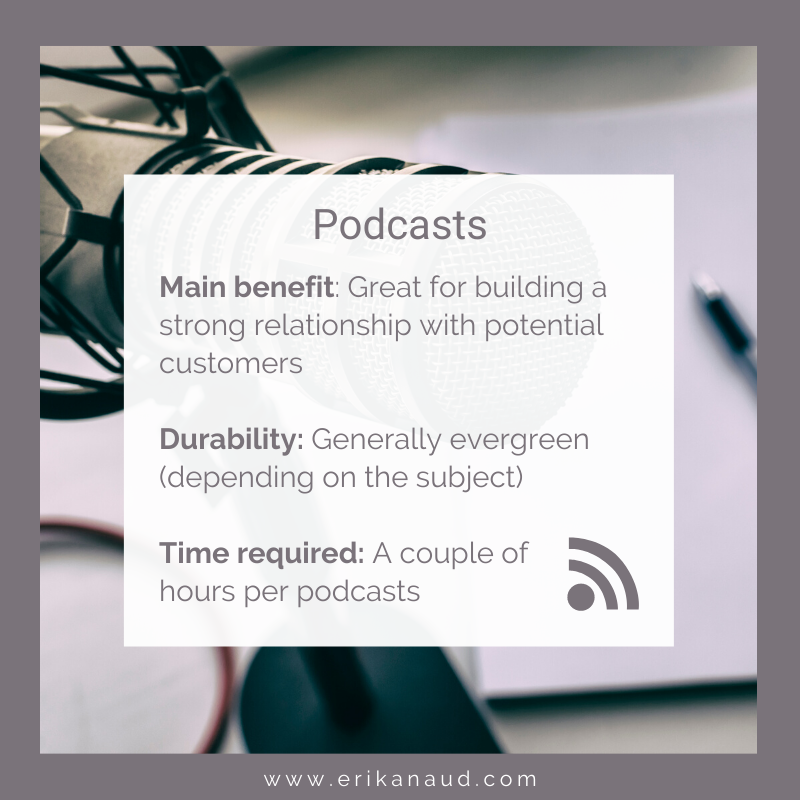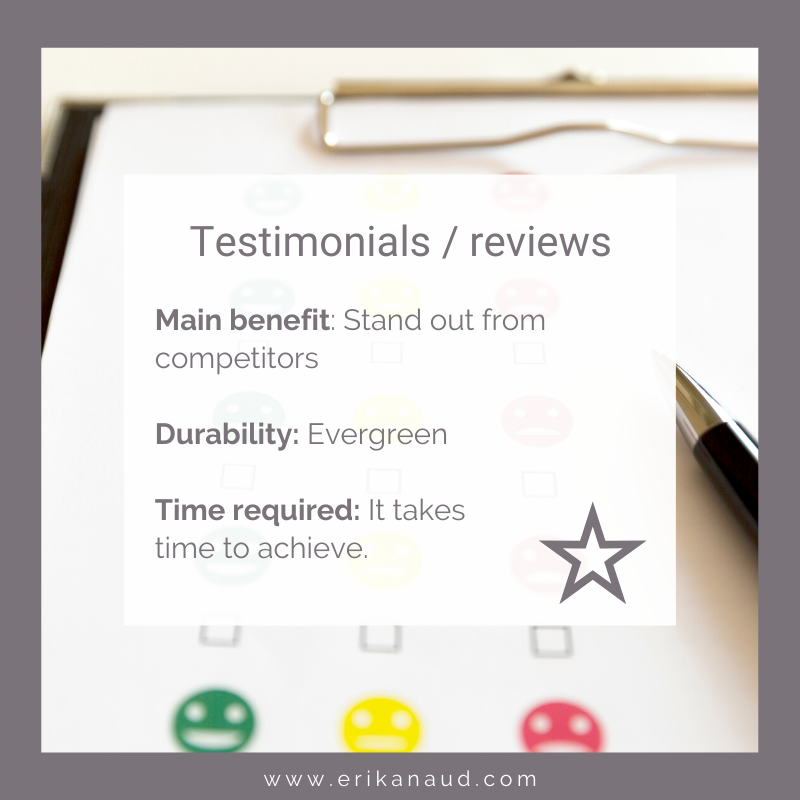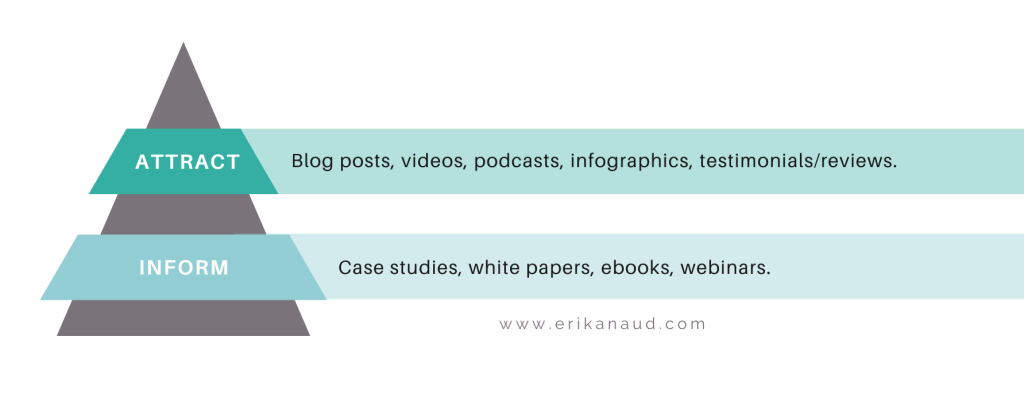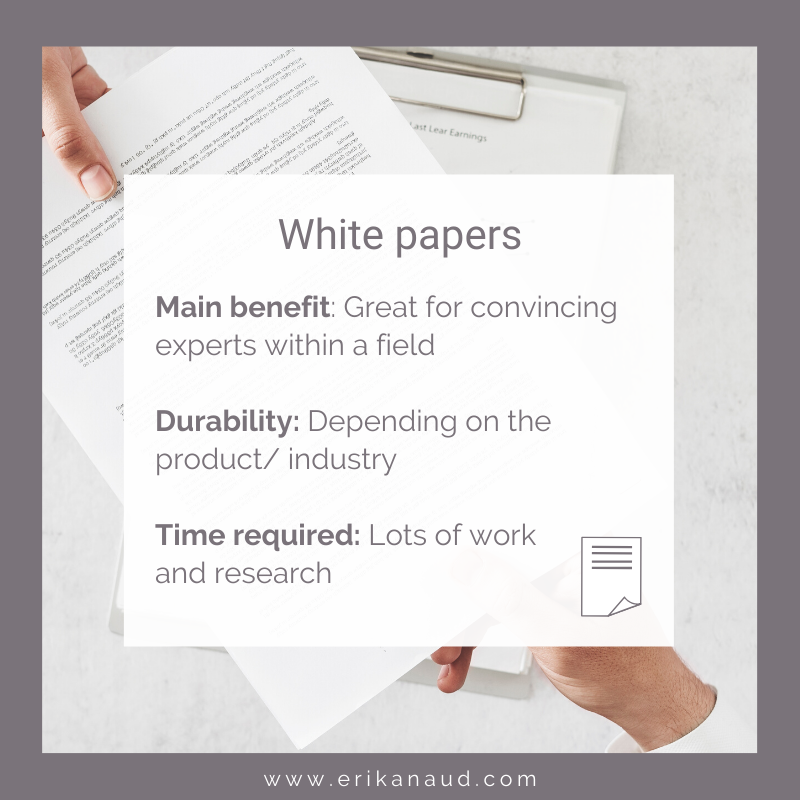Content marketing is the core of an inbound marketing strategy. It is the glue that holds all of the other elements together. So, you must put a lot of thought into implementing the right content strategy. And to do so, you need to know the different types of content there is out there. But, also how to use them efficiently and their main benefits.
In this blog post, I will review the main types of content with you. I split them into three sections: attract, inform, and close.

Attract
The first goal of your content strategy should be to attract your target group(s) to your website or your social media channels. The best way of achieving this is by offering them content that is related to their needs. Of course, the content should also be somewhat related to your product offering. The main types of content to attract potential customers are: blog posts, videos, podcasts, infographic, and testimonials/reviews.

1. Blog posts
Blogging is a type of content that is often perceived as a must-do in a successful inbound marketing strategy. That’s probably because having a blog comes with great benefits. The primary and non-negligible benefit is that blogging is excellent to attract customers on your website. But that’s not all. Blogging can also be great for building trust with your customers and positioning yourself as an expert within specific disciplines. From a long-term perspective, it will also help you convert returning visitors into leads.
Yet, blogging requires lots of work and knowledge on how to do it right. Ideally, you should be posting at least once a week. But, the more you post, the more traffic and ultimately leads you’ll get. You should be coherent, though, and not start blogging 3 times a week if you can’t keep up with that. I would recommend doing it once every two weeks, or once a week at first. And then, if it goes well, and you get good results, you can try to increase the frequency.
To get results with your blog, you should try to write SEO optimized blog post.

2. Videos
The main benefit that distinguishes videos from other types of content is engagement. Videos are great for engaging potential customers. And, you might not know it, but engagement is one of the most important criteria to rank well on Facebook in 2020. Similar to blog posts, videos are great for building trust.
Regarding SEO, videos are a must because they increase the time spent by visitors on your website. And as you might know, Google’s algorithms consider the average time spent by users when ranking websites. Moovly says that you are 53 times more likely to show up first on Google if you have a video embedded on your website. So, get started!
There are plenty of different videos you can make. From product reviews to a simple ad, take a look at this HubSpot guide to getting started. Because 2020 is definitely the year of videos.

3. Podcasts
Podcasts are very similar to videos, but they are usually easier to produce and edit. Thus, it can be a great alternative if you don’t have the best IT skills. Also, in a Podcast, listeners will always hear your voice, which is great because it will give you a more reliable connection with them. Listeners feel like they can relate more to someone they hear rather than to something they read. So, In the long term, you’ll develop a better relationship with your potential and current customers by doing podcasts.
Podcasts is also one of the best types of content to reach busy people as they can multitask while listening to a podcast. They can listen to your podcast in their car, on the bus, or even at the grocery shop. For some people, that’s way handier than reading a blog post or watching a video.

4. Infographics
Infographics are great because you can include lots of nice facts and stats on them. Thus, it’s an ideal way to simplify complex text and data for your readers. You can publish them on your website, but also on social media channels. Infographics are additionally known to go viral, and that’s an amazing way to boost your brand awareness. Also, they quickly catch the attention of viewers surfing online.
As you might have noticed, I like to include an infographic at the beginning of my blog posts. That way, people can have an overview of the content before reading the whole text. It helps readers understand the structure of my articles. Also, I can reuse these infographics later on social media.

5. Testimonials / Reviews
A testimonial is when someone says something nice about you, your company, and/or the work you do. A review can simply be someone who gives you 5 stars on Google, while a testimonial also includes a specific comment about you.
Reviews and testimonials are great ways to stand out from your competitors and to attract people to your website. For example, if you search for “Hairdresser Montréal”, you will probably look at the reviews available on Google. That’s how you’ll decide which websites to visit. So, having lots of great reviews/testimonials can also boost your trustworthiness.
How to get reviews and testimonials? You can simply ask.

Inform
Once you have attracted potential customers to your website or your social media channels, you need to inform them. Inform them about what you are offering, and how your offering can fill a need they have. Sometimes, they know the needs they have, but sometimes they don’t. So, that’s why some leads take longer to convince than others. But you must have some different types of content to transform your visitors into leads.

6. Case studies
Case studies and testimonials are often mixed up. But, there is a significant difference between them. Case studies are prepared. It is a document often built by you and a specific customer, where you highlight how your company helped this customer. A good case study does have a before and after comparison. How did your product offering solve their problems?
Case studies is one of the best types of content to get leads. After going to your website a couple of times, a potential customer will start being interested in your product offering. They will try to find out more about it. That’s where case studies are essential. You can learn more about case studies here. Although case studies are mainly used in B2B, they are also beneficial in B2C marketing. The most important is to have a call-to-action at the end of your case study. A possible call-to-action could be to book a free demo or to contact you for more information. It’s with this call-to-action that you transform visitors into leads, so make it great!

7. eBooks
eBooks are often available for free on company websites. Lots of marketers use eBooks to get people’s email addresses. But giving you their email addresses doesn’t mean you are allowed to send them publicity emails. Remember, they need to agree to be contacted before you send them emails. So, include a little box to get them to agree. But, keep in mind that email marketing is touchy, so avoid being pushy or annoying. Only send emails that are worthy, insightful, and visually appealing.
eBooks are usually used to inform beginners on a specific subject that is related to your product offering. They are aesthetic and full of eye-catching elements. In them, you can typically find a mix of information and fun-facts, to-do lists, product placement, etc.

8. White papers
White papers are often mistaken for eBooks, but they have significant differences. First, white papers are usually written for experts in the field. They are product-specific, with lots of comparisons between products and data. They work best in a B2B marketing context, where the product you are offering is very technical. White papers are also shorter than eBooks. They are typically 10-15 pages including footnotes and references to other sources. They are based on facts, and should look highly professional rather than pretty.

9. Webinars
A webinar is a web-based seminar. In a webinar, there is generally a presentation of 45 minutes about a specific subject. Then, there is a period for questions of 15ish minutes. Webinars are great because they help you connect with the participants, and learn their names and companies. Also, you might even discover their struggles and the reason why they signed up for your webinar. That’s amazing to include in your sales pitch later on in the sales funnel.
Companies frequently use webinars to explain how to use their products or services. You can also make one to talk about a specific subject you have covered in a blogpost or to show your expertise in a particular domain. For example, I did a guest seminar recently, where I explained what inbound marketing was. In the end, people asked specific questions regarding their inbound marketing strategies. These questions were terrific inspiration for future subject I should write about. Also, in the end, I recommended them to follow my Facebook page, and almost all of them did it. It was an easy way for me to get great leads.

Close
Now that your potential customers are informed about what you are offering, it’s time to close the deal. It is time for you to show that your product is what they need. That it will solve a specific problem they are facing.

9. Product comparison sheets
Having product comparison sheets is an excellent way to show potential customers that your offering beats the ones of your competitors. But do you need a product comparison sheet? That depends on your product offering. For example, if you are selling home-made woolen hats, you don’t need one! But if you are selling expensive products like imported coffee machines from Italy, it could be a good idea to do one. If you are selling SaaS (software as a service), you probably also do. In general, if your product is quite pricy, and has lots of different features, go for it.
A product comparison sheet will always compare the price. But you should also compare the different features. Also, consider comparing the support service. Try to make your product comparison sheets as easy to understand as possible and visually appealing. You can learn more about product comparison sheets here.

10. Free consultations
In a free consultation, your goal is to learn more about the needs of your potential client. This will help selling efficiently to him later on. I would say that in a free consultation, 80% of the time is about them, and then 20% is about your expertise. That 20% is necessary, as it is the value you give for this consultation. This expertise is not product-related; it is just your advice. Of course, at the end of a consultation, don’t forget to let your leads know about your product offering. You can also aim to book a sales meeting or a demo.
For example, if I would do a free one-hour consultation on Inbound Marketing with you, I would spend the first 40-50 minutes asking questions about your current marketing strategy. I would ask what you find difficult and where you need help. In the last 10-20 minutes, I would give you advice on how to achieve better results. These pieces of advice will be direct actions you can take or ideas you can use.
At the end of the consultation, if I see that you are interested, I could tell you how I could help you even more by suggesting weekly consultation meetings.

11. Demos
A demo, as opposed to the free consultation, is really product specific. In a demo, you are supposed to know the needs of your potential customer already. And, you should know precisely how your product offering can fulfill these needs. Thus, during the demo, you highlight how they can use your product. It should be concrete for them, and it should have the goal to convince them. In other words, it is a bit further down in the marketing funnel than the free consultation.
At the end of a demo, if you see an opening, you can directly do your sales pitch, or you can schedule a next meeting/call for that.

Conclusion
In this blog post, I reviewed the most used types of content for startups and entrepreneurs. There are, of course, lots of other types of content. One thing to keep in mind is that the types of content you decide to use should depend on your product offering. The more complex your product offering is, the more types of content you’ll need in your content funnel. So, if your product is easy to sell, and doesn’t have lots of features, then you might not need lots of them.
Moreover, you always need to think about the time and resources that different types of content require. If you don’t have a lot of time, try to prioritize. For example, if you are at the beginning of your marketing journey, attracting potential customers and building your brand will be the most important. But, later on, closing might become your first priority.

That was a very long blog post. Sorry about that! If you liked it, and want to read more tips and tricks to implement an effective inbound marketing strategy, then subscribe to my blog below by entering your email address.

